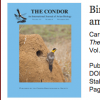
Autores:
Martínez del Río, C.
L. E. Eguiarte
Revista y/o libro:
The Condor
Volumen:
89, 357‑36
Año:
1987
Sinopsis:
We studied bird visits to the flowers of Agave salmiana at two sites on the Mexican Plateau. At one site the main visitors were four species of perching birds (Northern Flicker, Colaptes auratus; Curve-billed Thrasher, Toxostoma curvirostre; Scott's Oriole, Icterus parisorum; and Northern Oriole, Icterus galbula abeillei) and one hummingbird, the Magnificent Hummingbird (Eugenes fulgens). At a second site, plants were visited by five species of hummingbirds (E. fulgens; White-eared Hummingbird, Hylocharis leucotis; Berylline Hummingbird, Amazilia beryllina; Violet-crowned Hummingbird, Amazilia violiceps; and Blue-throated Hummingbird, Lampornis clemenciae), and the Cinnamon-bellied Flower-piercer, Diglossa baritula. At both sites, male E. fulgens defended inflorescences against other hummingbirds but not against perching birds. At one site, E. fulgens males defended inflorescences only in places with sparse vegetation; inflorescences located in areas with dense vegetation were visited by highly mobile nonterritorial hummingbirds. At both sites the numbers of birds in each inflorescence were a linear function of number of nectar-producing flowers. Arrival rates were also linearly related to flower numbers. For inflorescences with equal numbers of flowers, arrival rates were higher for hummingbirds than for perching birds. This resulted from the shorter residence times of the hummingbirds in the inflorescences. Different species of birds tended to use different parts of inflorescences.